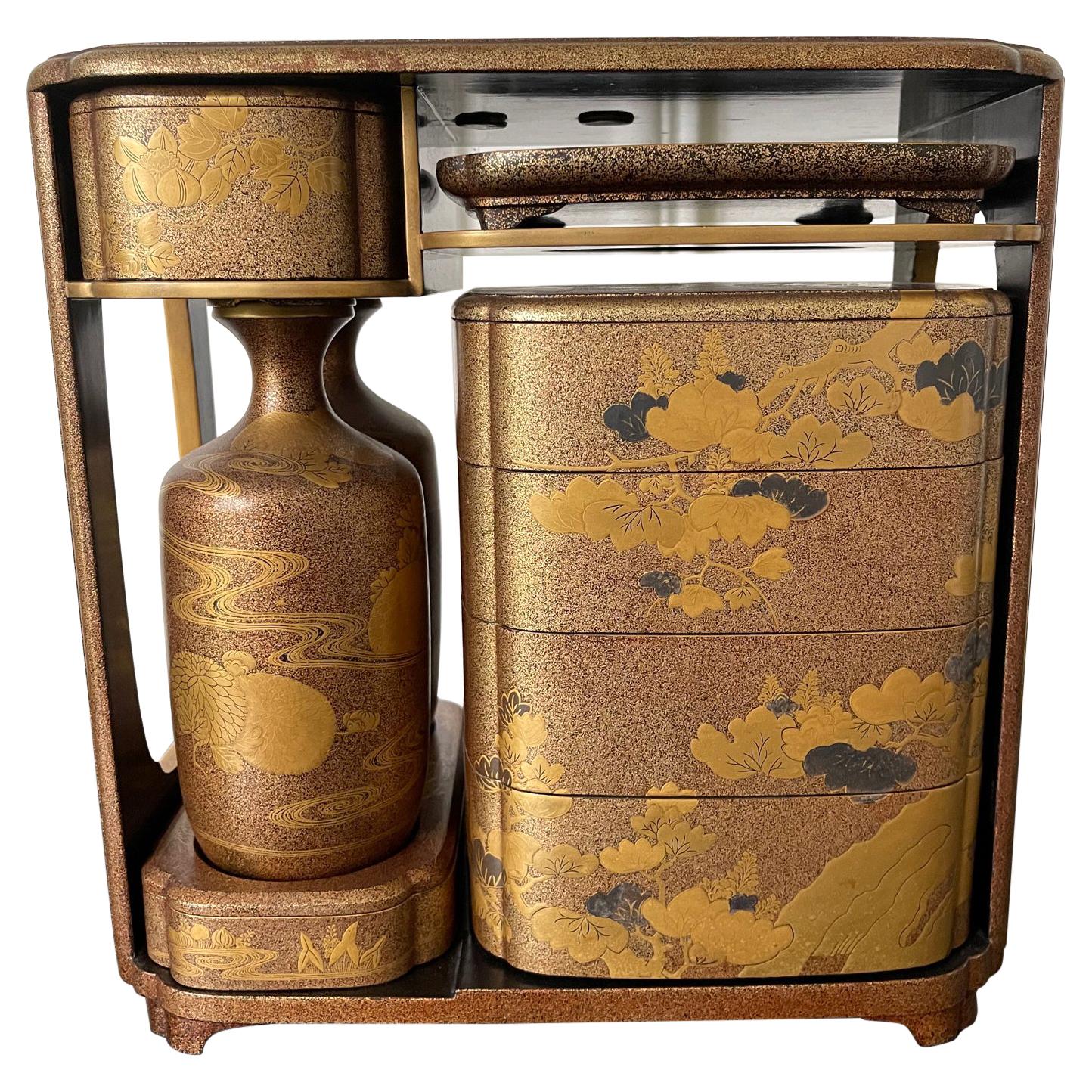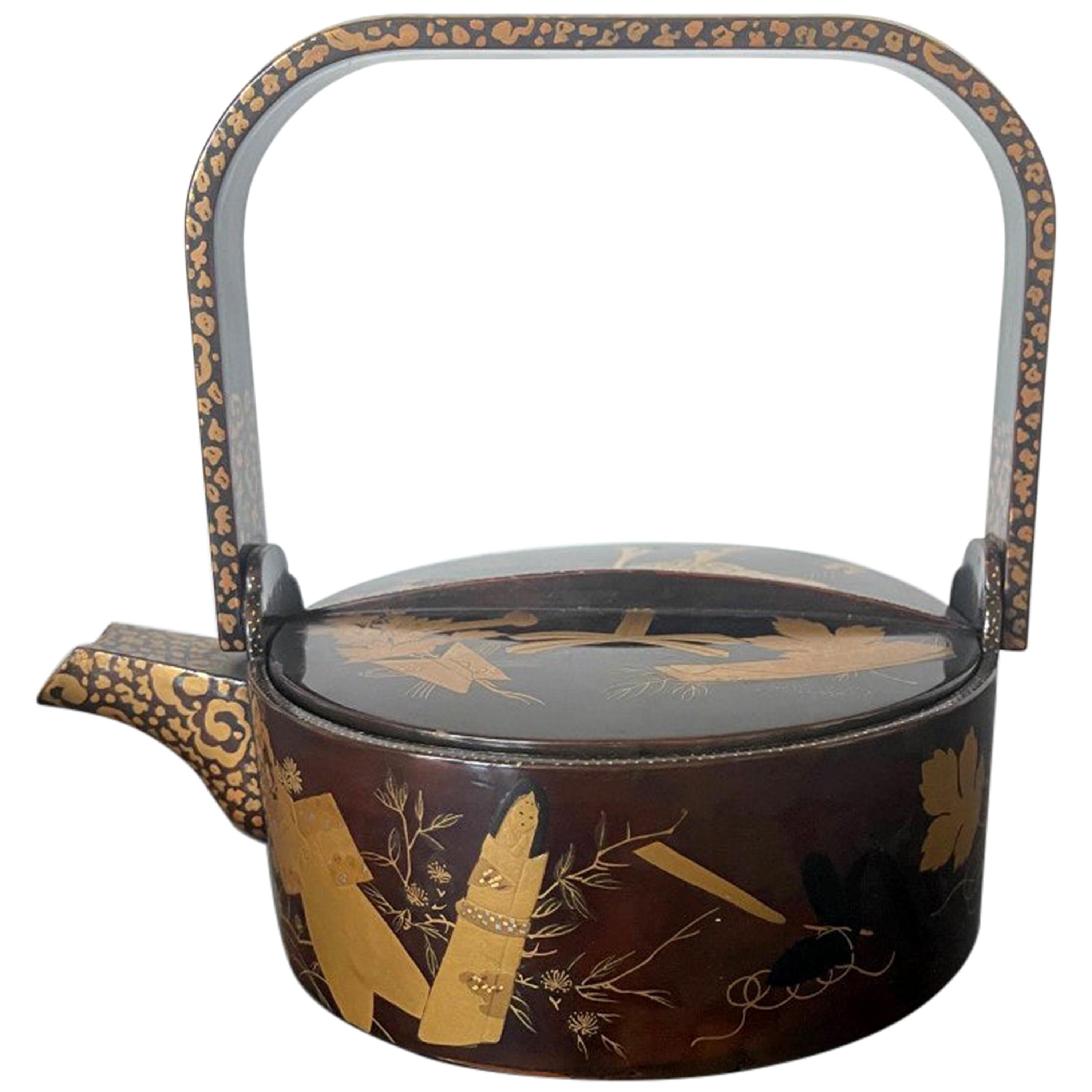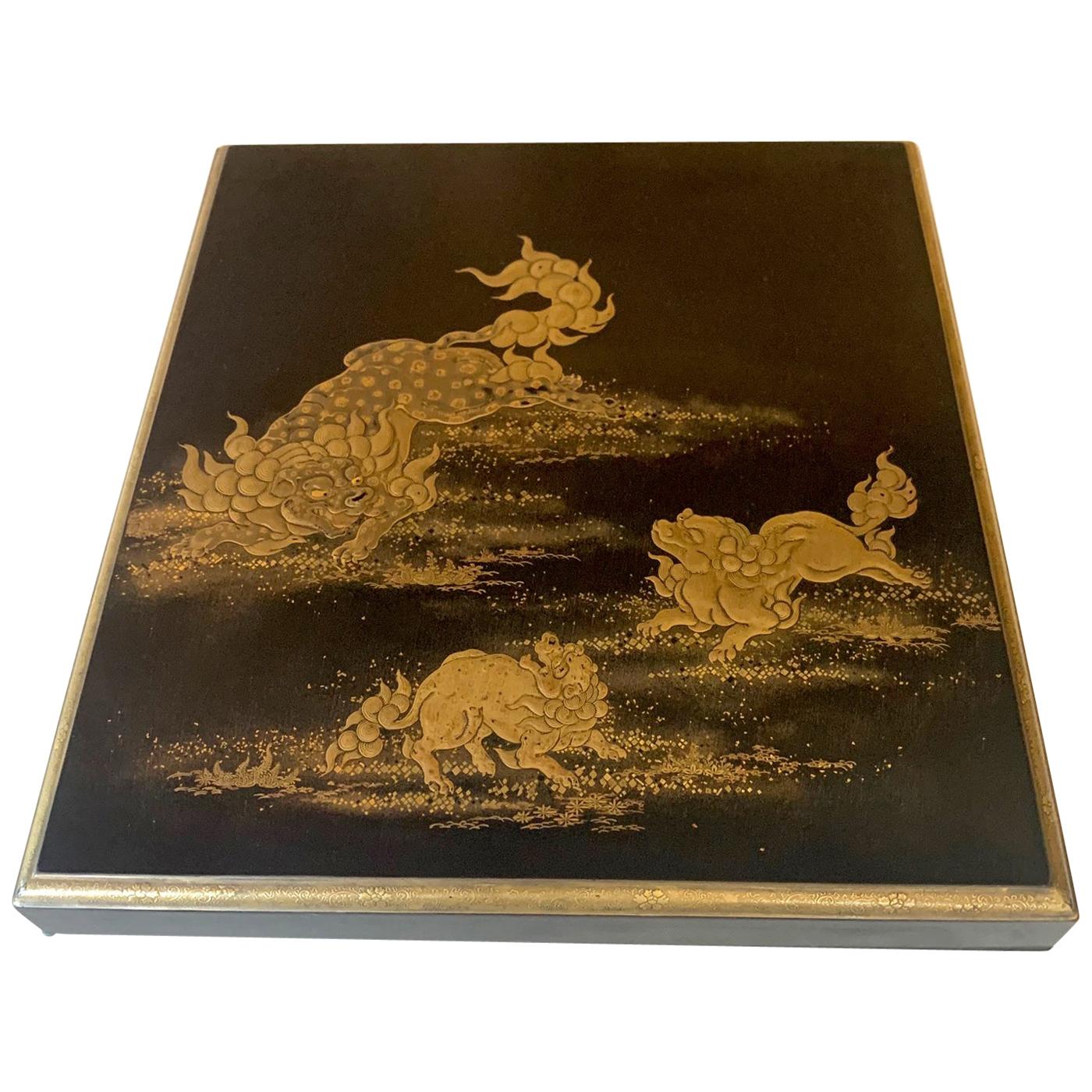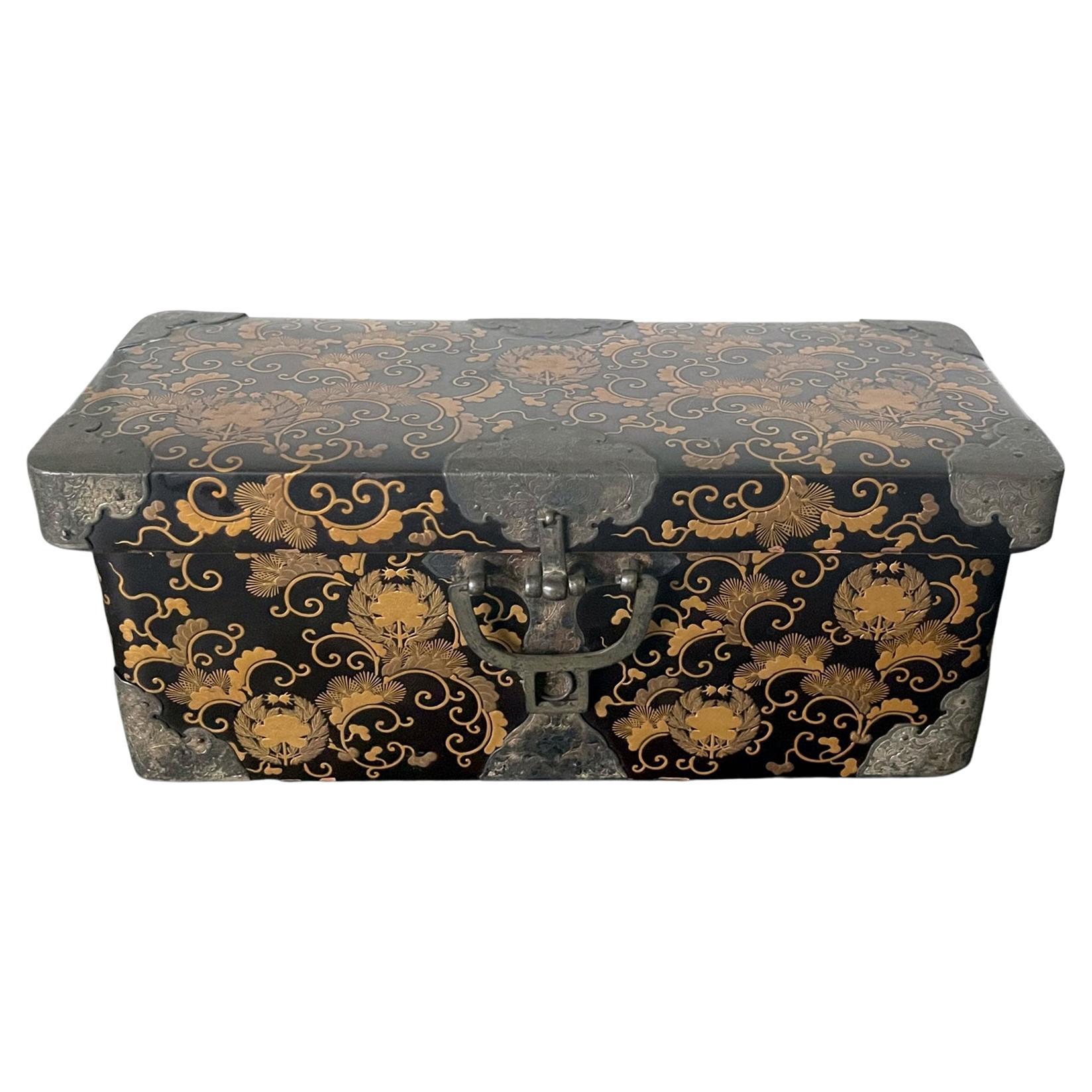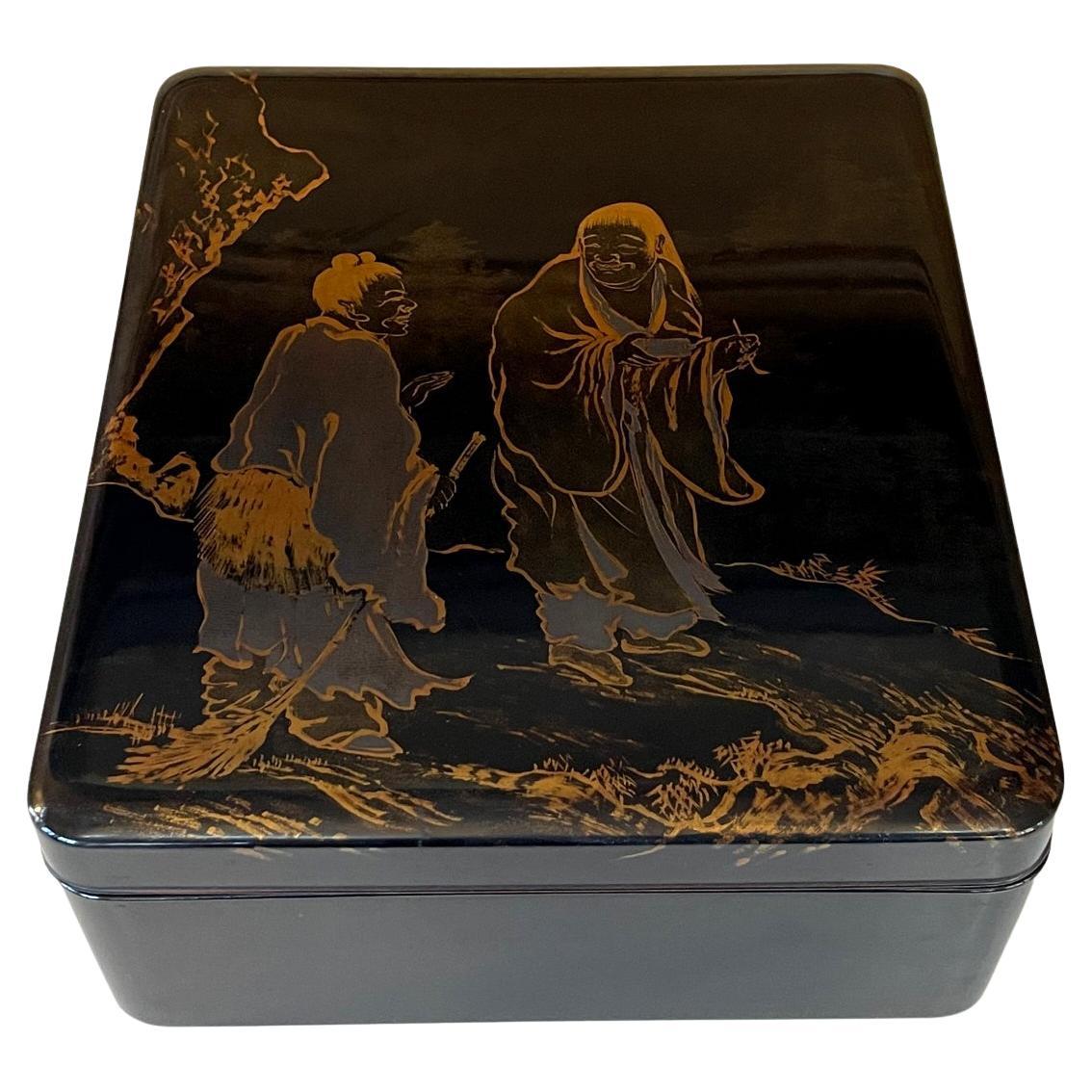Items Similar to Japanese Maki-e Lacquer Portable Sagejubako Theme of Three Winter Friends
Want more images or videos?
Request additional images or videos from the seller
1 of 21
Japanese Maki-e Lacquer Portable Sagejubako Theme of Three Winter Friends
About the Item
Sagejubako is a portable lunch or picnic set that became popular in the early Edo period when an additional meal was added between breakfast and dinner. It normally consists of a handled carry case and sake bottles, serving trays and tiered food storage boxes called "jubako". This set is rare not only because it appears to retain all the parts (it includes a carry case, seven trays, two sake bottles with lower compartment, a four-tiers jubako), but also because it is lavishly decorated in the motif of "Three Winter Friends: Pine, Bamboo and Plum blossom", one of the designs preferred by the scholarly type. Executed in gold hiramaki-e, takamaki-e and kirigane on black background, the three motifs were used in various combinations across the entire surfaces to decorate the trays, sake bottles, jubako and also exterior top of the carry case. The carry case itself is wonderfully constructed with an all-around lattice wall of overlapping coin design, a symbol for good fortune. All interior of the containers was finished in a vermilion red. The set was finely crafted with bold composition and painstaking workmanship.
The set is likely dated to the second half of 19th century (early Meiji period). There are a minor loss and some stable aged cracks in addition to expected patina, nevertheless it remains a beautiful and well-preserved example.
- Dimensions:Height: 14.5 in (36.83 cm)Width: 14 in (35.56 cm)Depth: 8 in (20.32 cm)
- Style:Japonisme (Of the Period)
- Materials and Techniques:
- Place of Origin:
- Period:
- Date of Manufacture:Second Half of the 19th Century
- Condition:Wear consistent with age and use. Minor losses. Expected patina on parts of the surface. A few stable aged cracks to the front door of, one small loss to the coin lattice as shown. One lower container under the sake bottle has a crack on the back wall that was touched up at some point.
- Seller Location:Atlanta, GA
- Reference Number:1stDibs: LU945029170472
About the Seller
5.0
Platinum Seller
These expertly vetted sellers are 1stDibs' most experienced sellers and are rated highest by our customers.
Established in 2006
1stDibs seller since 2010
479 sales on 1stDibs
Typical response time: <1 hour
- ShippingRetrieving quote...Ships From: Atlanta, GA
- Return PolicyThis item cannot be returned.
More From This SellerView All
- Japanese Maki-e Lacquerware Portable Picnic Set SagejubakoLocated in Atlanta, GASagejubako is a portable picnic set that became popular in the early Edo period when an additional meal was added between breakfast and dinner. It normally consists of a carry case w...Category
Antique 19th Century Japanese Japonisme Lacquer
MaterialsLacquer
- Japanese Maki-e Lacquer Stack Box JubakoLocated in Atlanta, GAAn antique jubako (stack boxes) with five tiers in an elongated octagon shape circa 19th century (end of Edo or beginning of Meiji period). jubako was traditionally used to store and...Category
Antique 19th Century Japanese Japonisme Lacquer
MaterialsWood, Lacquer
- Japanese Lacquer Maki-e Sake Ewer Meiji PeriodLocated in Atlanta, GAA Japanese lacquered wood sake ewer with maki-e design, circa late 19th century, Meiji period. The nicely decorated lacquerware is of a Classic sake ewer for...Category
Antique 1890s Japanese Japonisme Lacquer
MaterialsLacquer
- Japanese Lacquer Box with Fine Maki-e Decoration Meiji PeriodLocated in Atlanta, GAA lacquered wood box with lid from Japan circa 19th century Meiji Period. The finely decorated box was used to store paper slips and small documents on the desk. It is overall finished with black lacquer (kuro) with sparse Mura-Nashiji effect outside and on the top surface of the lid, there are three Komainu, (sometimes known as Shishi or Japanese lions) frolicking and forming a circle in lively motion. Komainu are auspicious animals in Japanese cultures in both Shinto and Buddhism tradition. Originally from China, these animals symbolizes guardians to ward off evil spirits. Hiramaki-e was used in combination with carving and combing to render the lions with various surface textures. A gilt border with an slight angle was given to the lid and even the thin band is decorated with miniature floral scrolls. The interior of the box was finished in a dense nashiji. Underneath the lid, a cluster of peonies open lavishly by two gentle mounts. Takamaki-e (high relief) in both gold and silver were...Category
Antique Late 19th Century Japanese Japonisme Lacquer
MaterialsWood, Lacquer
- Japanese Antique Lacquer Maki-E Miniature Hasami-Bako with Copper MountsLocated in Atlanta, GAA Japanese lacquered box with lid in the shape of a miniature Hasami-Bako (traveling chest) circa late 18 to early 19th century of the Edo period. The black box is decorated with fin...Category
Antique Early 19th Century Japanese Japonisme Lacquer
MaterialsCopper
- Japanese Lacquer Maki-E Tiered Suzuribako and RyoshibakoLocated in Atlanta, GAA Japanese roiro lacquer scholar combo box with an upper tier of inkstone box (Suzuribako) and a lower document box (Ryoshibako) circa 1910-30s (end of Meiji to Showa period). The high glossy box was beautifully decorated with an image of the famously eccentric Buddhist monks Hanshan and Shide (known in Japan as Kanzan and Jittoku). Often as a pair, they have been a popular motif in Japanese Zen painting...Category
Vintage 1920s Japanese Meiji Lacquer
MaterialsStone, Metal
You May Also Like
- Japanese Maki-e Lacquer Stacking Box, Jubako, Meiji Period, JapanLocated in Austin, TXA fine and impressive Japanese gold maki-e decorated black lacquer five-tier jubako with presentation tray, two lids, and the original tomobako storage box, Meiji period, late 19th c...Category
Antique Late 19th Century Japanese Meiji Lacquer
MaterialsLacquer
- Signed Japanese White Lacquer and Maki-E Lacquer Tansu, Meiji PeriodLocated in Ottawa, OntarioThe case decorated overall in crackle-glaze white lacquer and fitted with a patinated metal carrying handle over three tiers of small drawers. The first two tiers are comprised of a ...Category
Antique Late 19th Century Japanese Meiji Lacquer
MaterialsLacquer
- Japanese Meiji Period Antique Lacquer Box with Gold Maki-e DecorationLocated in New York, NYA fine antique Japanese Meji Period lacquer box decorated with a fan and a stylized star shaped window in the maki-e technique. The fan at the top right corner, fully opened depictin...Category
Antique 19th Century Japanese Meiji Lacquer
MaterialsLacquer
- Japanese Black Lacquer Document Box with Gold Maki e Design, Meiji PeriodLocated in Prahran, VictoriaAn antique black lacquer document box with an exquisitely detailed, finely wrought design from The Tale of the Genji depicted in gold maki e across the lid. Internally, the box is de...Category
Early 20th Century Japanese Lacquer
MaterialsWood, Lacquer
- Antique Japanese Lacquer O-Bento Box with Gold and Silver Maki-E DecorationLocated in Prahran, VictoriaAn unusual hexagonally shaped antique Japanese three-tiered o-bento box with a carrying tray decorated with a classical Rimpa style gold and silver Maki-e lacquer design of gently sw...Category
Antique Early 1900s Japanese Meiji Lacquer
MaterialsLacquer, Wood
- Japanese Lacquer Hokai Box, 19th CenturyLocated in Pasadena, CAThis is a good example of a traditional Japanese Hokai shell storage box for the Kai-awase game. This box is well-detailed in chased brass appliques and makie. The box is in overall ...Category
Antique Late 19th Century Japanese Japonisme Lacquer
MaterialsWood, Lacquer
Recently Viewed
View AllMore Ways To Browse
Black Lacquer Design
Black Lacquer Storage
Patina Lacquer Furniture
Carrying Case
Antique Theme
Black Gold Lacquer
Gold And Black Lacquer
Red Black Lacquer
Black And Red Lacquer
Type Of Call
Black Lacquer Wall
Lacquered Bamboo
Lacquered Bamboo Furniture
Black Lacquer Patina
Antique Carrying Case
Bamboo Black Lacquered
Lacquer Black Tray
Red Lacquer Box
